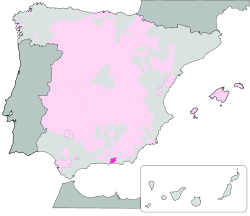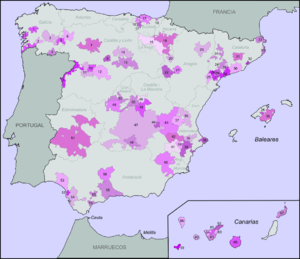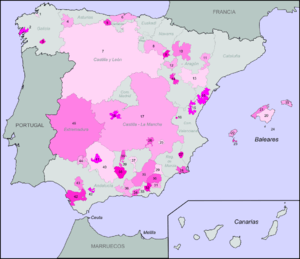Cumbres del Guadalfeo
Cumbres del Guadalfeo (previously called Contraviesa-Alpujarra [1]) is a Spanish geographical indication for Vino de la Tierra wines located in the Alpujarras mountains, in the autonomous region of Andalusia. Vino de la Tierra is one step below the mainstream Denominación de Origen indication on the Spanish wine quality ladder.
| Wine region | |
 | |
| Type | Vino de la Tierra |
|---|---|
| Country | Spain |

Cumbres del Guadalfeo in Andalucía.
The area covered by this geographical indication comprises the following municipalities: Albondón, Albuñol, Almegíjar, Cádiar, Cástaras, Lobras, Murtas, Polopos, Rubite, Sorvilán, Torvizcón, Turón, and Ugíjar, in the province of Granada (Andalusia, Spain).
It acquired its Vino de la Tierra status in 2004.[2]
Grape varieties
- Red: Garnacha tinta, Cabernet Franc, Pinot noir, Syrah, Cabernet Sauvignon, Tempranillo and Merlot
- White: Jaén blanco, Montúa, Perruno, Vijiriego, Pedro Ximénez, Chardonnay and Moscatel
gollark: No, actually.
gollark: Try opening control panel as admin or something.
gollark: Oh, you are?
gollark: Oh, are you not admin? Right.
gollark: Anyway, you probably **can** uninstall it.
References
- Orden de 4 de febrero de 2009, por la que se modifica la Orden de 22 de noviembre de 2004, por la que se establecen las normas de utilización de la mención «Vino de la Tierra Contraviesa-Alpujarra» para los vinos originarios de la comarca vitivinícola Contraviesa-Alpujarra de la provincia de Granada.
- "Archived copy" (PDF). Archived from the original (PDF) on 2007-04-12. Retrieved 2013-10-21.CS1 maint: archived copy as title (link) Ministerio de Agricultura, Pesca y Alimentación. In Spanish
This article is issued from Wikipedia. The text is licensed under Creative Commons - Attribution - Sharealike. Additional terms may apply for the media files.

